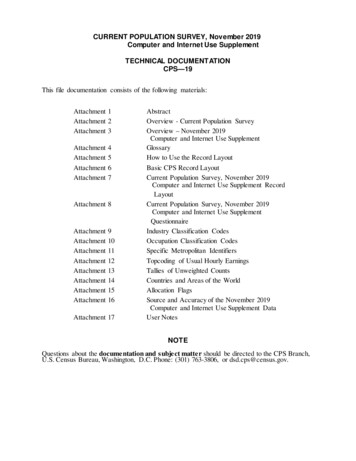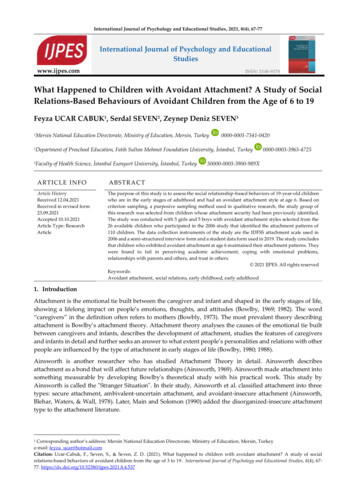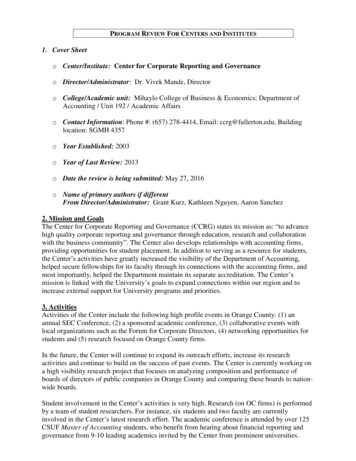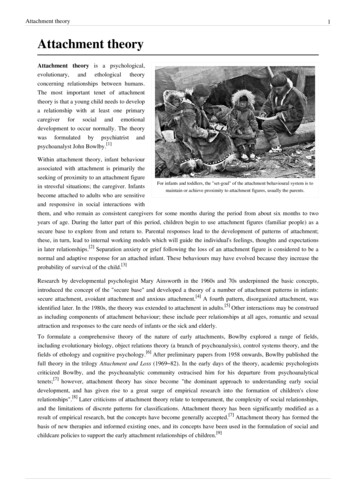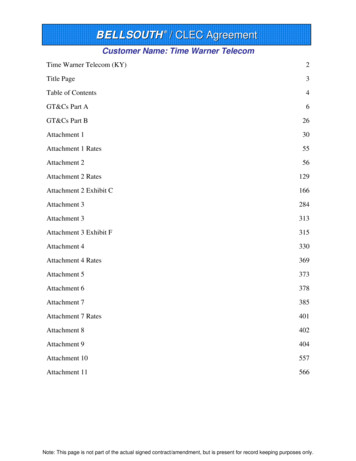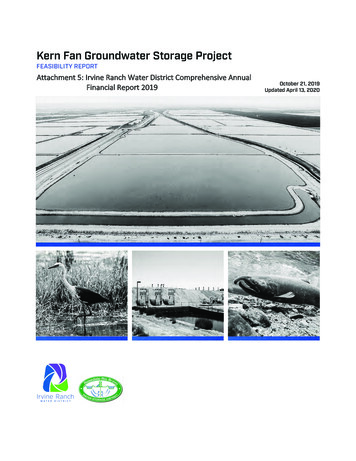
Transcription
Attachment 5: Irvine Ranch Water District Comprehensive AnnualFinancial Report 2019
Sustainability & GrowthIrvine Ranch Water DistrictIrvine, CaliforniaCOMPREHENSIVE ANNUALFINANCIAL REPORTfor fiscal year ended June 30, 2019
This page intentionally left blank.
Comprehensive Annual Financial ReportFor fiscal year ended June 30, 2019Irvine Ranch Water DistrictIrvine, CaliforniaBoard of DirectorsSteven E. LaMar, PresidentMary Aileen Matheis, Vice PresidentDouglas J. ReinhartPeer A. SwanJohn B. WithersGeneral ManagerPaul A. CookPrepared by:Irvine Ranch Water DistrictFinance Department
This page intentionally left blank.
Table of ContentsIntroductory Section1 Letter of Transmittal2 Profile of Irvine Ranch Water District2Overview2People3Services5Infrastructure Assets62019 Accomplishments6Future Goals7Water Use Efficiency8Legislative and Regulatory Affairs8Financial Plan10User Rates & Charges12Factors Affecting Financial Condition12Financial Planning & Budgeting13Pension Funding14Cash Management Policies and Practices14Real Property Investments15Debt Management Policies and Practices16Risk Management16 Major Initiatives16Water Supply Reliability18Expanded Water Recycling Options,Resource Recovery and System Reliability19Community Education and Outreach21 Awards and Acknowledgments22 List of Principal Officials23 Organizational Chart by Function24 GFOA Certificate of Achievement forExcellence in Financial ReportingFinancial Section26 Independent Auditors’ Report29 Management’s Discussion and Analysis(Required Supplementary Information)38 Basic Financial Statements:38Statement of Net Position40Statement of Revenues, Expenses andChanges in Net Position41Statement of Cash Flows43Notes to the Basic Financial Statements86 Required Supplementary Information:86Defined Benefit Pension Plan89Other Post-Employment BenefitsStatistical 116117119120121122123124125126Net PositionChanges in Net PositionWater Sold by Type of CustomerWater RatesLargest Water CustomersSewer RatesLargest Sewer CustomersAd Valorem Property Tax RatesAssessed Valuation and Estimated ActualValue of Taxable Property and 1% PropertyTax RevenueDirect and Overlapping Property Tax RatesPrincipal Property TaxpayersProperty Tax Collections/DelinquencyOutstanding Debt by TypeOutstanding General Obligation Bonds byImprovement DistrictRatio of General Obligation Debt toAssessed ValuesRatio of Annual Debt Service Expendituresto Total General ExpendituresDebt Service CoveragePrincipal EmployersDemographic and Economic StatisticsOperating Indicators by Function - Waterand Sewer Service ConnectionsOperating Indicators by Function - NewService ConnectionsOperating Indicators by Function - AverageMonthly UsageSource of Supply and Water Deliveries/SalesCapital Asset StatisticsFull-Time EmployeesINTRODUCTORY SECTION
This page intentionally left blank.
Introductory SectionIrvine Ranch Water DistrictFiscal Year Ended June 30, 2019INTRODUCTORY SECTION
This page intentionally left blank.INTRODUCTORY SECTION
December 16, 2019To The Board of Directors,Irvine Ranch Water District:Management of the Irvine Ranch Water District (IRWD or the District) has prepared a ComprehensiveAnnual Financial Report of IRWD for the fiscal year ended June 30, 2019. This document, whichcontains a complete set of basic financial statements, is presented in conformity with generally acceptedaccounting principles (GAAP) and audited in accordance with generally accepted government auditingstandards by a firm of licensed certified public accountants. State law requires that all special-purposelocal governments publish these basic financial statements within six months of the close of the agency’sfiscal year.This report contains management’s representations concerning the finances of the District. Managementassumes full responsibility for the completeness and reliability of the information contained in thisreport. To provide a reasonable, rather than absolute, basis for making these representations, IRWDmanagement has established a comprehensive framework of internal controls. These controls aredesigned to protect the District’s assets from loss, theft, or misuse, and to ensure sufficiently reliableinformation for the preparation of the District’s basic financial statements in conformity with GAAP.Because the cost of internal control should not exceed anticipated benefits, the objective is to providereasonable, rather than absolute, assurance that the basic financial statements are free of any materialmisstatements. As management, we assert that this financial report is complete and reliable in allmaterial respects.The District’s basic financial statements have been audited by Davis Farr LLP, a firm of licensedcertified public accountants. The goal of the independent audit was to provide reasonable assurance thatthe basic financial statements of the District for the fiscal year ended June 30, 2019 were free of materialmisstatements. The independent audit involved examining, on a test basis, evidence supporting theamounts and disclosures in the basic financial statements, assessing the accounting principles used andsignificant estimates made by management, and evaluating the overall financial statement presentation.The independent auditor rendered an unmodified opinion that the District’s basic financial statementsfor the fiscal year ended June 30, 2019 are fairly presented in conformity with GAAP. The independentauditor’s report is presented as the first component of the financial section of this report.A profile of the District is presented in this Introductory Section. In the Financial Section, Management’sDiscussion and Analysis (MD&A) immediately follows the independent auditor’s report and providesan overview and analysis of the basic financial statements. This letter of transmittal and introduction isdesigned to complement the MD&A and should be read in conjunction with it.INTRODUCTORY SECTION1
Profile of Irvine Ranch Water DistrictOverviewIrvine Ranch Water District was established in 1961 as a California Water District under the provisions ofthe California Water Code. As a special district, IRWD focuses on four primary services - providingpotable water, collecting sewage, producing and distributing recycled and other non-potable water, andimplementing urban runoff source control and treatment programs.IRWD is an independent public agency governed by a five-member, publicly elected Board of Directors.The members of the Board each have varied professional backgrounds, coupled with an average tenure forthe Board members of approximately 25 years. The District is a leader in developing and implementingresource management initiatives such as water recycling, urban runoff control and treatment, waterefficiency, and water banking. The District is a pioneer in financial management practices such as variablerate debt financing and long-term infrastructure replacement program development and funding.The District serves a 181 square mile area, which includes all of the City of Irvine and portions of thecities of Tustin, Newport Beach, Costa Mesa, Orange and Lake Forest, as well as certain unincorporatedareas of Orange County. Extending from the Pacific Coast to the top of the foothills of eastern OrangeCounty, the District’s region is semi-arid with a mild climate and an average annual rainfall ofapproximately 12 inches. The total estimated daytime population served is approximately 600,000 andincludes approximately 117,000 water and 111,000 sewer service and recycled water connections. Thenumber of service connections has increased by approximately 21% over the last ten years.The District provides its core services to its customers by focusing on the following areas: Operational Reliability – having multiple sources of water supply, various sewage treatmentalternatives, and emergency power capabilities to ensure reliable services. Organizational Strength – having professional staff work in close collaboration with the Boardof Directors striving to exceed the expectations of our customers. Long-Term Financial Planning – ensuring sufficient funds are available to construct, operate,maintain, and replace facilities, while retaining competitive rates now and in the future.PeopleThe District employs approximately 400 staffwho are responsible for administering dailyoperationsandimplementingstrategicobjectives and policies set forth by the Board.The District actively promotes the training andeducationofemployeestoincreaseeffectiveness and retention. The average tenureof District employees is approximately 10 years.2INTRODUCTORY SECTION
ServicesThe District is functionally organized into four core service areas:Drinking or “Potable” Water SystemFor many years, the District received virtually all of its drinking water from imported sources. Tominimize this dependence on imported water, in the early 1980’s, the District developed a series oflocal wells known as the Dyer Road Wellfield to access high quality groundwater from the OrangeCounty Groundwater Basin, managed by the Orange County Water District (OCWD).IRWD also operates many other groundwater wells with water from some of these wells requiringtreatment. In Fiscal Year (FY) 2018-19, local groundwater accounted for 54% of the District’s totalwater supply.Groundwater currently is significantlyless expensive, more reliable, and lessenergy intensive than imported waterthat is transported over hundreds ofmiles into Southern California andsubsequently treated.The District purchased 16% of its watersupply in FY 2018-19 from theMunicipal Water District of OrangeCounty (MWDOC), the region’s localwholesale water supplier. This water isimported from both the Colorado River,which is transported approximately 240miles through deserts and over mountainranges to Southern California, and fromthe Delta, from which water istransported approximately 400 milesfrom Northern California.Water SourcesFiscal Year 2018-19Runoff Capture(Irvine 16%Recycled and Non-Potable Water SystemsThe District treats sewage to provide water for irrigation, commercial, industrial and agriculturalpurposes which further reduces its reliance on the more expensive imported water and increases itssystem reliability. Sewage from the community is collected and recycled to California State WaterResources Control Board Title 22 standards at the Michelson Water Recycling Plant and the Los AlisosWater Recycling Plant, which have the combined capacity to produce nearly 33.5 million gallons oftertiary recycled water per day. The District produced and utilized over 7 billion gallons in the currentfiscal year.Once treated, the recycled water is distributed throughout the service area and in FY 2018-19accounted for approximately 25% of the District’s total water supply. Approximately 80% of allbusiness and community landscaped areas (parks, school grounds, golf courses, street medians, etc.)in the District’s service area are irrigated with recycled water. The District also provides recycledwater for various industrial and commercial uses. IRWD’s goal is to recycle its sewage flows wherebyrecycled water will represent 25% to 30% of its total water supply after the District’s service area isfully developed.INTRODUCTORY SECTION3
The District operates a non-potable system which includes 5 wells, 5 open reservoirs and 12 tanks thatstore water for non-potable uses. In total, the District has approximately 4,500 acre feet of activerecycled water storage capacity. IRWD has a majority ownership in Irvine Lake, a 25,000 acre-feetreservoir that can capture and store stormwater and can also store imported water supplies.Sewage Collection and Treatment SystemThe District has an extensive network of gravity sewers, force mains, sewage lift stations, and siphonsthat convey sewage to two District-owned water recycling plants or the Orange County SanitationDistrict (OCSD). In FY 2018-19, the District treated approximately 77% of its sewage while theremainder of the sewage collected by the District was diverted to the OCSD treatment facilities. TheDistrict plans to expand its treatment capacity when necessary to serve its growing population. Thisexpansion is discussed in more detail in the Major Initiatives section of this document.Urban Runoff Source Control and Treatment SystemIRWD is statutorily authorized to control and treat urban runoff, and conducts various projects andprograms as part of an effort to protect water quality in the San Diego Creek watershed. In the 1990s,the District constructed wetlands at the San Joaquin Marsh where natural biological processes remove asubstantial pollutant load from San Diego Creek dry weather flow before it reaches the environmentallysensitive Upper Newport Bay State Ecological Reserve. The District operates a regional urban runofftreatment network known as the Natural Treatment System (NTS). As of June 30, 2019, the NTSconsists of 39 constructed wetland treatment sites located throughout the San Diego Creek Watershedand one outside of the IRWD service area with several more currently under construction. In addition,IRWD has recently added an urban runoff diversion facility along Peters Canyon Wash, which pumpsrunoff resulting from selenium-rich high groundwater into OCSD’s sewers, eventually flowing toOCWD’s groundwater replenishment system.San Joaquin Marsh4INTRODUCTORY SECTION
Infrastructure AssetsThe District builds and maintains significant capital infrastructure in order to provide superior service toits customers. The table below provides key information relating to its water and sewer system assetsfrom 2010 to 2019.Infrastucture AssetsPotable SystemMiles of Water LineNumber of Storage TanksMaximum Storage Capacity (acre feet)Number of Pumping StationsNumber of WellsWell Production Capacity (cfs)Water Banking Storage Capacity (acre feet)Potable Treatment PlantsNon-Potable and Recycled SystemsMiles of Recycled LineNumber of Storage TanksNumber of Open ReservoirsMaximum Storage Capacity (acre feet)Number of Pumping PlantsNumber of WellsWell Production Capacity (cfs)Sewer SystemMiles of Sewer LineNumber of Lift StationsTreatment PlantsTreatment Capacity (mgd) (Tertiary)Sewage Flows to Michelson PlantSewage Flows to Los Alisos PlantSewage Flows to Orange County Sanitation 94018223.566%14%20%1,13423233.565%12%23%1 acre foot 325,900 gallonscfs cubic feet per secondmgd millions gallons per dayINTRODUCTORY SECTION5
2019 AccomplishmentsThe District has a Strategic Planning Process where the Board annually adopts goals and annual targetactivities. The approved Target Activities are associated with eighteen goals for the District toaccomplish within the next five years. Major accomplishments achieved in FY 2018-19 are:1. Implemented a 2-year budget and Proposition 218 noticing.2. Executed key agreements to optimize Irvine Lake as a water resource facility for IRWD, and itspartners. Resolved issues regarding use of Irvine Lake for water rights and quality and participatedin developing an interim agreement to initiate fishing at the lake.3. Completed construction and initiated start-up of the 200 million Michelson Water Recycling PlantBiosolids & Energy Recovery Facilities capital project for the handling of solids, which will costeffectively provide resource recovery ofsolids and gas for IRWD.4. Continued to promote water use efficiencyand long term conservation measuresleading District’s customers to have one ofthe lowest residential gallons per capita perday (gpcd) rates in California. In 2018-19,IRWD’s residential water use (indoors andoutdoors) averaged 64 gpcd, which was35% lower than the statewide average of 99gpcd.5. Completed triennial Benchmark SalarySurvey to ensure District salaries remaincompetitive to market rates.6. Completednewthree-yearlaboragreements with represented personnel.Biosolids and Energy Recovery Facilities7. Initiated construction of the remainingSand Canyon Office property. The investment contributes to keeping customer rates low.8. Implemented re-designed customer bill to enhance customer understanding and communication.9. Fully funded IRWD employee pension plan, including the Pension Plan Trust which contains fundsadequate to cover the District’s CalPERS projected pension liability as of the current fiscal year end.10. Received the United States Environmental Protection Agency’s WaterSense Excellence Award andthe Silver Anvil Award for Community Outreach from the Public Relations Society of America.Future GoalsThe District has the following Board adopted goals for IRWD to accomplish within the next five years,along with Target Activities that are typically accomplished within 12 to 18 months:1. Optimize and protect local water supply utilization: develop and implement projects to increaseIRWD’s access to local groundwater and stormwater capture.2. Evaluate and invest in projects and programs that will enhance future long-term water supplyreliability: pursue projects and supply arrangements to enhance water supply reliability, includingincreased water banking and water recycling. Provide additional water storage opportunities forregional water supply reliability.3. Optimize use of Irvine Lake as a water resource facility for IRWD and its partners: resolve propertyrelated issues and implement projects which will enhance the safety of the reservoir.6INTRODUCTORY SECTION
4. Develop water banking recharge, storage, and extraction capacity for IRWD and water bankingpartners, and store water as it becomes available: continue development of IRWD water bankingfacilities in Kern County.5. Develop and implement the Kern Fan Groundwater Storage Project: execute agreements and secureadditional water storage investment funding.6. Develop water recycling facilities and applications for optimal benefit: identify new opportunitiesfor IRWD to utilize recycled water locally.7. Maximize resource recovery from fully functional biosolids and other resource recovery facilities:continue start-up of IRWD’s Biosolids and Energy Recovery Facilities.8. Improve energy service reliability, manage demands, and control costs: implement cost-effectivebattery storage and solar power installations. Develop capability to continue operation of keyfacilities during short and long–term power outages.9. Maximize watershed protection: control and treat urban runoff while preventing sewer spills.10. Ensure financial and rate stability: ensure adequate funding for future infrastructure replacementneeds, continue to provide low rates for IRWD customers, maintain strong financials through soliddebt coverage, liquidity balances, mixed debt profile, and pension plan obligation funding of at least90 percent.11. Identify, assess and implement new technologies and systems to improve operating efficiency:implement new systems such as Enterprise Asset Management while protecting existing and futuresystems through advanced cybersecurity measures.12. Enhance customer communications: Implement improved customer web access portal andstrategically extend community outreach.13. Maximize water use efficiency in the community: explore future opportunities for increased wateruse efficiency and expand database for improved analytics.14. Recruit, develop and retain a highly skilled, motivated, and educated work force: develop employeeskills, develop and implement employee expectations for corporate values and ensure appropriateemployee compensation.15. Guide and lead local, state and federal policies and legislation: actively engage in issues of keyinterest to IRWD including water use efficiency, water rate structures, and others.16. Engage and shape policies and regulations put forth by local, state and federal agencies: influenceregulations to align with best practices for recycled water use and other applications.17. Increase collaboration with other agencies and entities through leadership and innovation: engage ata high-level in industry associations, regional water agencies, and development of opportunities ofmutual benefit for IRWD and partners.18. Implement opportunities that enhance safety, security, and emergency preparedness throughout theDistrict: protect the health and safety of IRWD employees and facilities.Water Use EfficiencyThe District continues to be a leader in the innovation and implementation of water use measures thatpromote the most efficient use of water, both on a per capita and per acre basis.The District’s budget-based tiered rate structure, implemented in 1991, was carefully designed topromote the efficient use of water by providing customers pricing signals related to over-use of water ina financially sustainable way. This structure is recognized as a model for other agencies to emulate.In 2016, Governor Brown issued an Executive Order calling for Californians to build on the actions takenduring the recent statewide drought, and to “Make Conservation a Way of Life in California”. Inresponse, legislation requiring statewide long-term water use efficiency passed in 2018. As a result, theINTRODUCTORY SECTION7
state will establish new long-term water efficiency objectives by June 30, 2022. IRWD has a long historyof implementing cost-effective water efficiency programs, and it is well prepared to meet the futureefficiency standards. The District’s customers have one of the lowest residential gallons per capita perday (gpcd) rates in California.The District’s Water Use Efficiency Plan provides a comprehensive strategy that includes environmentalconsiderations and addresses the considerable financial benefits of water use efficiency for the Districtand its customers. Specifically, the Plan addresses: Increasing water demands and the impact to the District’s unit cost of water, which would increaseif the District needed to purchase more expensive imported water. Reducing urban runoff (typically the result of “over-watering”) which minimizes water qualitydegradation from fertilizers, pesticides and animal waste in creeks, rivers and the ocean. Reducing water demands, which reduces energy usage and related costs needed to convey water. Reducing water use indoors, which results in reduced sewage generation and attendant treatmentcosts and capital costs for additional infrastructure.The basic tenets of the Water Use Efficiency Plan include local, state and national policy developmentand leadership, rate structure improvements, focused customer interface, extensive education andoutreach, technology advances, and the development of financial incentives.During the past fiscal year, the District provided financial incentives to residential and businesscustomers to install water efficient devices such as high efficiency clothes washers, toilets, irrigationequipment, and conversions from high water use turf landscape to water-efficient landscapes. Due tothe investments made by the District to diversify its resources, expand the use of recycled water andimprove water use efficiency, IRWD provides reliable, high quality water to its customers in a costeffective manner.The District has also led the use of recycled water beginning in the late 1960s and presently serves over6,100 sites, with approximately 28,000 acre feet of recycled water sold in FY 2018-19 representing 25%of the District’s total water supply. The use of recycled water reduced the District’s need to import moreexpensive potable supplies.Legislative and Regulatory AffairsThe District actively monitors and works to influence local, state and federal legislation, policies andregulatory actions that could affect IRWD’s operations, existing and future facilities and strategicplanning efforts. The Board of Directors is frequently engaged in, and takes active positions on, relevantpending legislation and regulatory actions. The District continues to engage proactively in policydiscussions surrounding water use efficiency, recycled water, and water rates in California. The Districtand its Board of Directors also participate in state and regional trade associations including theAssociation of California Water Agencies, the California Association of Sewer Agencies, the WaterReuse Association, the California Special District Association, and the California Municipal UtilitiesAssociation.Financial PlanNew this year, the Board approved a two-year (biennial) operating budget to improve IRWD’s long termplanning, enhance funding stability, and create greater efficiency in the budgeting process. The goal ofthe District’s operating budget process is to appropriately fund the resources required to provide8INTRODUCTORY SECTION
excellent service to IRWD customers as cost-efficiently as possible. The graph below shows the actualoperating expenditures through FY 2018-19, as well as the Board approved operating budgets for FY2019-20 and 2020-21. Increases reflect costs associated with customer growth within the District, aswell as an increase in overall operating expenses. Increases have been kept to a minimum byaggressively pursuing reductions in expenses to offset uncontrollable expenses, such as pass-throughrate increases from outside agencies.Operating Expenditures 190Budget 170Millions 150 130 110Actual 90 70 50ActualFiscal YearsBudgetThe approved FY 2019-20 budget increased to 167.0 million from 157.1 million or 6.3% from FY2018-19 and to 173.6 million or 4.0% in FY 2020-21. The primary reasons were increases in laborand associated benefits for additional positions necessary to support new operating facilities, increasesin the cost of water due to rate increases from outside agencies, and higher operating and maintenancecosts associated with new facilities coming on line. The decrease in FY2015-16 expenses is primarilydue to lower water demands.The Board also approved a two-year capital budget based on new, enhancement and replacementinfrastructure needs. The following chart shows the actual capital expenditures through FY 2018-19and the budget for FY 2019-20 and FY 2020-21.Capital Expenditures 160(1)Millions 140 120 100 80BudgetActual 60 40Actual(1)Fiscal YearsBudgetActual capital expenditures excluding overhead, intangibles and capitalized interest.INTRODUCTORY SECTION9
The reduced spending in 2012-13 and 2017-18 from prior years represents the District’s completion ofseveral projects including the MWRP Upgrade Project, the Baker Water Plant, and the subsequentdesign phase for the Michelson Biosolids and Energy Recovery Facilities, which began construction inFY 2013-14. The Board approved capital budget was 90.9 million for FY 2019-20 and 93.8 millionfor 2020-21. Many capital budget projects extend beyond one fiscal year.User Rates & ChargesUser rates and charges are primarily used to fund the District’s operation and maintenance expenses.The District separates the cost of constructing water and sewer infrastructure from the cost of dailyoperations and maintenance. User rates, as discussed below, are billed to customers on a monthly basis,and include a component for the inevitable replacement of existing infrastructure. The District setsreplacement monies aside in advance to help stabilize rates and avoid significant potential future rateimpacts. In 2015, the District completed a detailed cost of service study which confirmed that user ratesbilled to customers are based on actual costs to provide the services.The District allocates capital costs within its service area through the use of water and sewerimprovement districts, for which general obligation bond authorization is obtained and used as neededto fund new capital projects. Ad valorem property tax rates are set annually by the District, as areconnection fees paid by property developers and landowners. Generally, the District’s policy is toallocate the cost of new infrastructure evenly between the developers/landowners and the ultimateproperty owners who utilize the water and sewer infrastructure.Water RatesThe District’s rate structure for water use is separated into a commodity charge component and a fixedservice charge component. The commodity charge reflects the cost of providing the District’s watersupplies while the fixed service charge funds the fixed operational and maintenance expenses of theDistrict. For FY 2018-19, the District’s water fixed service charge was 10.35 per month. The Districthas a long history of planning for the inevitable replacement of capital infrastructure, and sets moniesaside into enhancement and replacement funds for this purpose. In FY 2018-19, the monthly fixedservice charge includes a user enhancement and replacement component of 0.70 and 2.10,respectively, per month, intended to fund current and future replacement and refurbishment costs thatprovide reliability and redundancy to the District’s infrastructure.The District has a four-tiered rate structure that promotes water use efficiency. A basic use allocation isestablished for each customer account that provides a reasonable amount of water for the customer’sneeds based on factors such as the number of occupants, type or classification of use, size of theirrigated area, evapotranspiration rate for the billing period and other consistently applied criteria.The chart below illustrates the four-tier structure that reflects the increased cost associated with usage inthe higher tiers.10INTRODUCTORY SECTION
FY 2018-19 Residential Rate Structure – Potable Water (Commodity Charge)Percent of EstimatedTierCustomer NeedCost per ccfLow Volume0 – 40% 1.40Base Rate41 – 100% 1.89Inefficient101 – 140% 4.73Wasteful141% 13.35One ccf (100 cubic feet) 748 gallonsAs of June 2019, approximately 81% of the District’s customers were within the first two tiers andapproximately 94% of customers fell within the District’s first three tiers. IRWD r
Comprehensive Annual Financial Report For fiscal year ended June 30, 2019 Irvine Ranch Water District Irvine, California Board of Directors Steven E. LaMar, President
